A Cow Named Lu
As I was driving back from an errand an hour or so southwest of home, a highway sign alerted me to a total closure of I-5 a few exits north due to an accident. I chose my own detour and found myself in a little town that I had never passed through before. The main drag took me right past their farmer’s market which happened to be going on that afternoon.
None of the several markets I had been to in my new home region had a dairy vendor, which was disappointing and baffling for a county that has a fair number of cattle. It was a lucky detour that day. I came home with a half gallon of what turned out to be the sweetest, richest milk I’ve ever tasted. The vendor was very proud of his product and evidently loved his animals. He even labels the jar by their names.
This week’s dairy perfection brought to you by a cow named Lu. Naturally, there is also a Thelma.
I normally don’t drink half a gallon of milk a week, and I wasn’t sure how long the raw milk would keep. When I buy pretty-good pasture-raised-but-pasteurized milk from PCC I do so a quart at a time and more often than not the last cup turns before I get to it. It would be a crime to let that happen to milk from Lu.
Ice cream, of course! I’ve been wanting for ages to make homemade ice cream. Half an hour of Google research turned up any number of ice cream recipes insisting on their superiority and one fabulous article about different methods for making ice cream without an official ice cream machine. The food processor method seemed like it would work best for me.
A homesteading blog post theorized, sensibly I thought, that one is defeating some of the purpose of raw milk by cooking it to make custard for ice cream the way some of the more sophisticated recipes call for. The same blogger also theorized that considering the gobs of raw cookie dough she had eaten in her life without negative consequence, some raw egg in raw ice cream that goes straight from farm-fresh to frozen should be just fine. I am in that camp all the way!
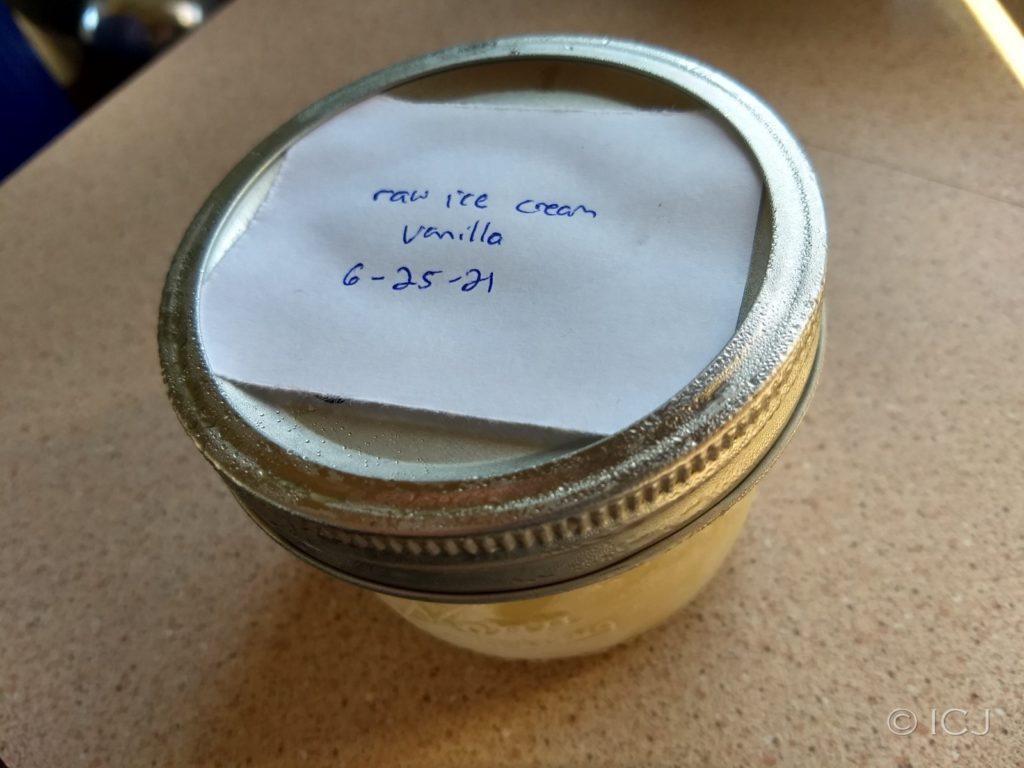
Raw ice cream:
3 cups fresh raw milk, including most of the cream off the top. I let it settle and layer out again after having gently mixed it to enjoy the first cup of cold milk full-cream for the complete experience.
1 duck egg. Several recipes insisted on 3-6 eggs or yolks per quart recipe of ice cream. I can’t imagine. Duck eggs are extra-rich and the yolks are large and really dark orange, even more so than a healthy farm-fresh chicken egg. Just one gave the ice cream a deep ‘French vanilla’ yellow. Perhaps the presence of the egg is what makes it French-style ice cream? I have since made this recipe again with a chicken egg. Much as I prefer the richness of duck eggs hard-boiled, I think I prefer the chicken for ice cream.
2 T honey, from Four Cedars in Glenoma.
1 tsp vanilla
a pinch of salt
Whisk the egg with the honey until the honey is at least somewhat dissolved. Add vanilla and well-chilled milk, whisk again briefly, and pour into a 9×9 casserole dish. Freeze.
Thaw just until you can get the ice cream scoop in. Blend in food processor until it is milkshake consistency. Put in individual serving containers (I did 8 oz wide mouth canning jars but snack-size Tupperware or even paper cups would work for kids) and immediately refreeze.
The trick for creamy ice cream, besides lots of cream, is having it freeze fast. The crystals are smaller that way. By churning the near-solid-state batter you break up the crystals and evenly distribute the coldness. Back into the freezer, nestled between other frozen things, ASAP, and leave them there with the freezer closed.
Thaw for a few minutes in the fridge so you can get a spoon in but it doesn’t turn to soup around the sides. It doesn’t need any help to be delicious but if you have fresh berries you might as well decorate it with those!
I also froze a cup of the milk unmodified to see how it fared. I’d love to be able to buy it farm-direct in the winter once or twice a month and keep some on hand for baking and hot cocoa. It thaws out just fine.
Foodshed Challenge Rundown: All food grown/raised/foraged/hunted in stated geographical area excepting imports allowed on Homegrown days (coffee, olive oil, salt, and yeast) + County and State days (chocolate, butter, maple syrup, and spices that do not grow in WA).
County Foodshed Day – June 11
Breakfast: Scrambled Eggs, Apple Juice, Coffee
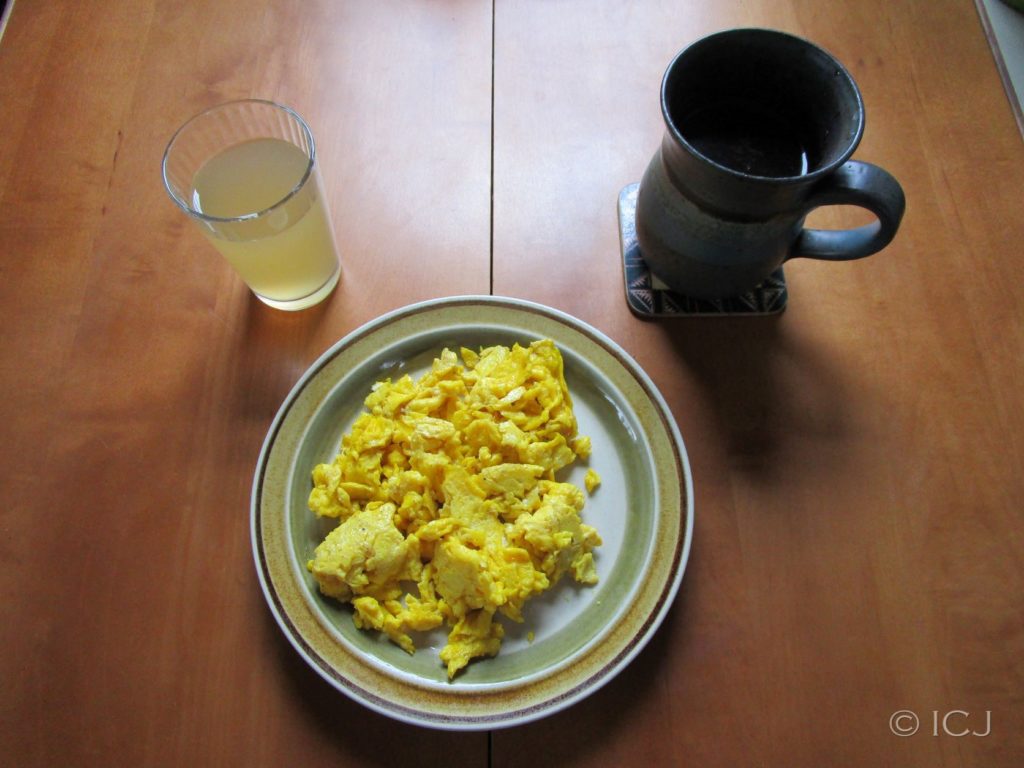
Chicken eggs from Cryptid Creek across my north fence, butter. Apple juice from boiled apple mash left over from cider process (homegrown). I thaw a gallon bag of the mash and simmer it with half a gallon of water and then strain in a colander. (A mesh strainer clogs hopelessly with the pulp.) It yields 4-6 cups of juice that is better than grocery store apple juice though not as good as the first run cider.
Tea: Cleavers with Honey
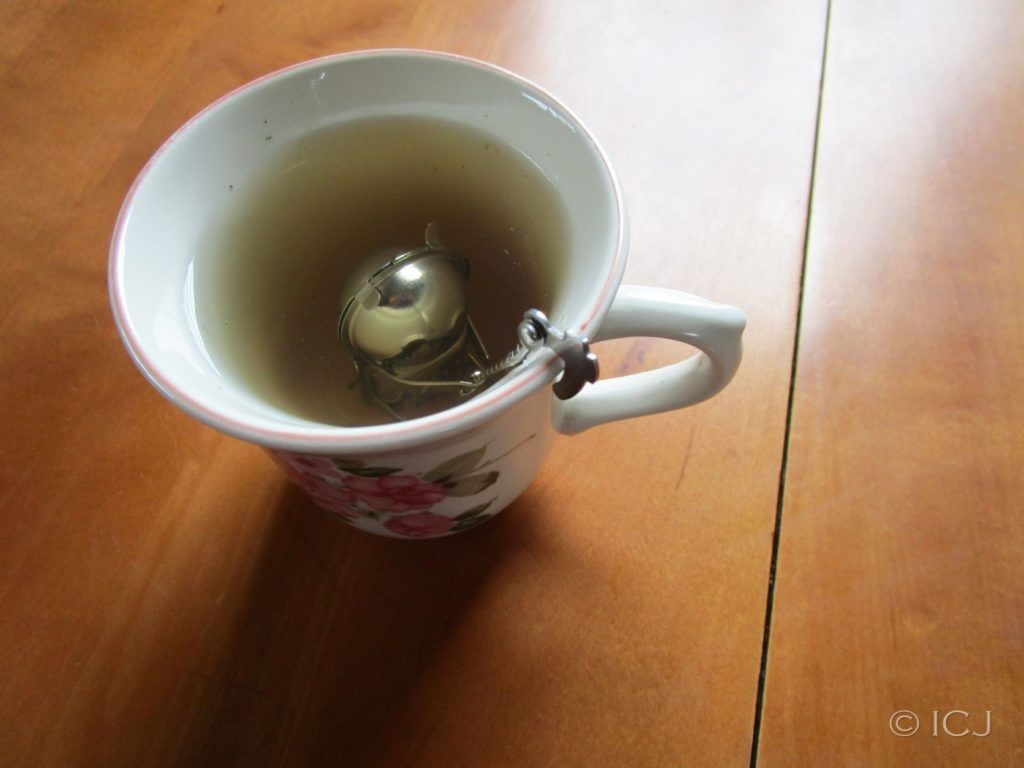
Cleavers are the spindly grassland and woodland plant with whorls of sticky leaves and tiny burrs. I harvested a couple grocery bags full last year and dried for a pleasant-tasting medicinal tea. Honey from Four Cedars (Glenoma). The tea ball is a climber rappelling, though it looks more like an astronaut with its big head. I couldn’t resist.
Morning Snack: Blackberries with Maple Syrup, Double Mint Tea
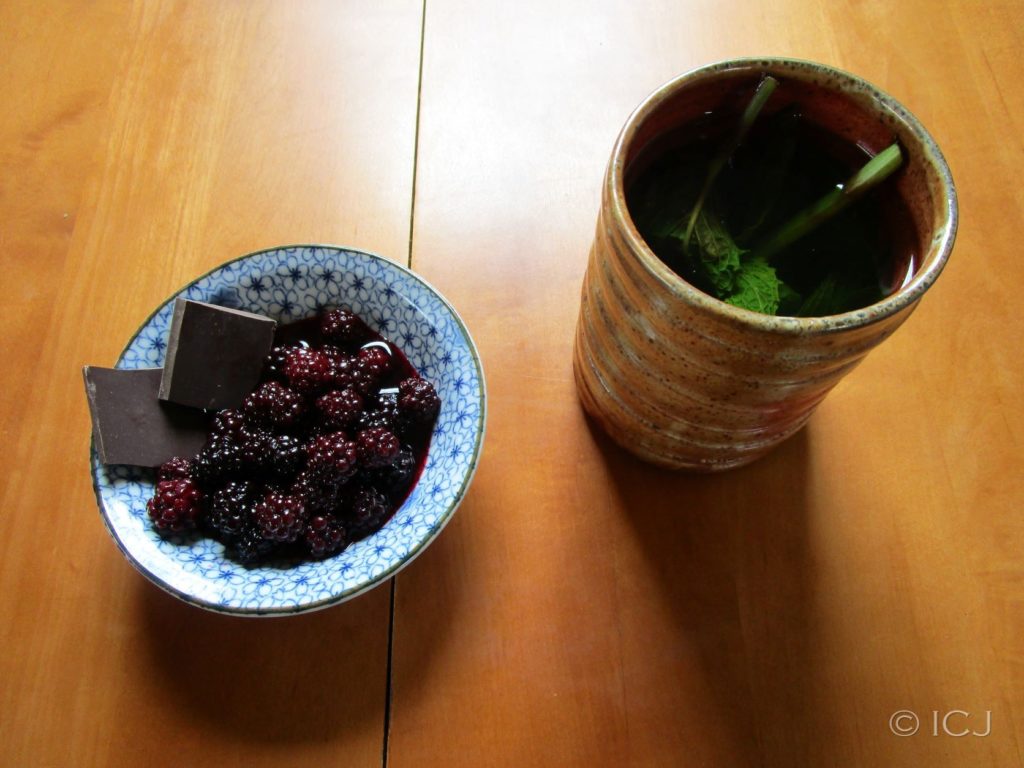
Blackberries and mint homegrown. Theo chocolate on the side.
Lunch: Sauteed Radishes and Garlic, Roasted Beets
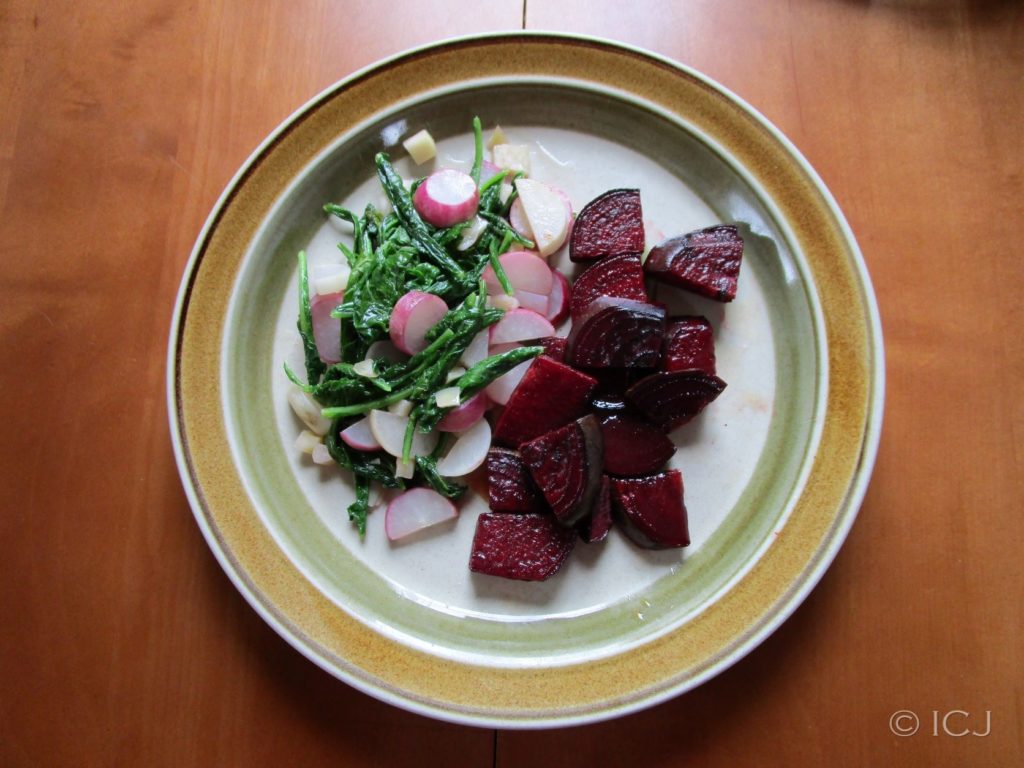
Radishes (Chehalis farmer’s market), garlic (Root Cellar Farm, Onalaska), butter. Beets (Root Cellar Farm, Onalaska, fall 2020!), olive oil.
Radish greens are edible cooked and best a day or two after the radishes are picked. The radishes themselves keep several times longer if their greens are cut off just about the radish tops right away. I rinse them well as grit likes to stick to their fuzzes and then sautee in butter. If you are also cooking the radishes you can slice them thin so they can go in the pan all at the same time. Beet roasted on a tray in the toaster oven.
Afternoon Snack: Raw Ice Cream, Strawberries, Coffee
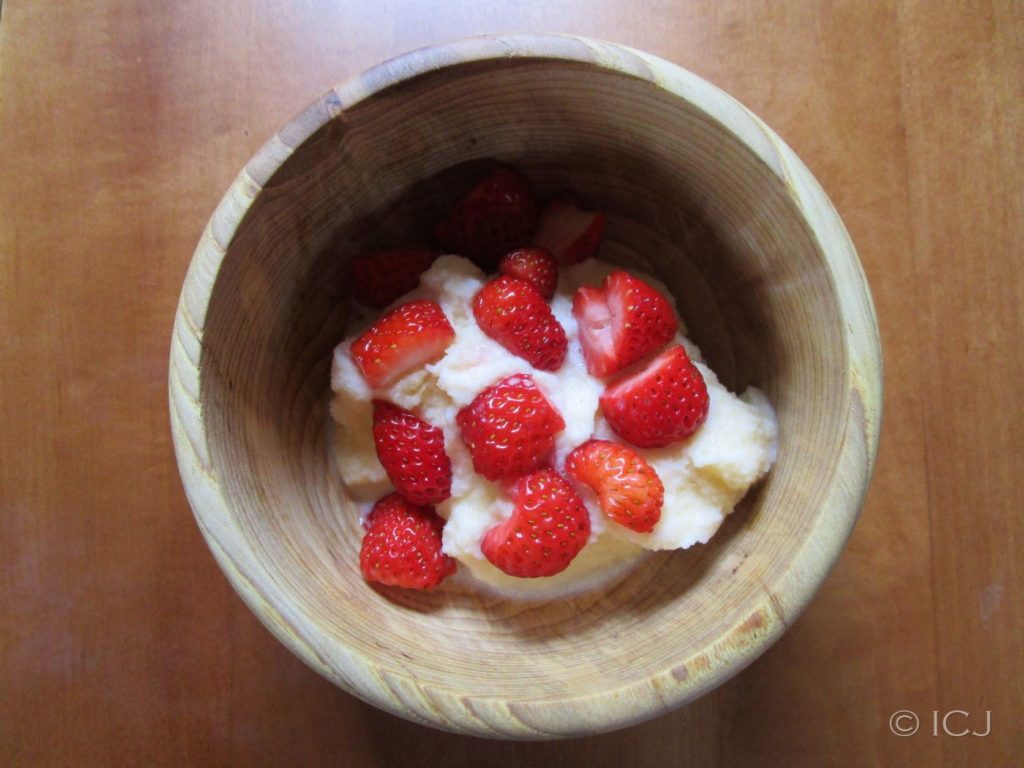
Ice Cream – Milk (Glenoma), duck egg (Mossyrock), honey (Four Cedars, Glenoma), vanilla.
Strawberries homegrown.
Dinner: Rainbow Chard with Shallot, Pork, and Chanterelle, Hard Cider
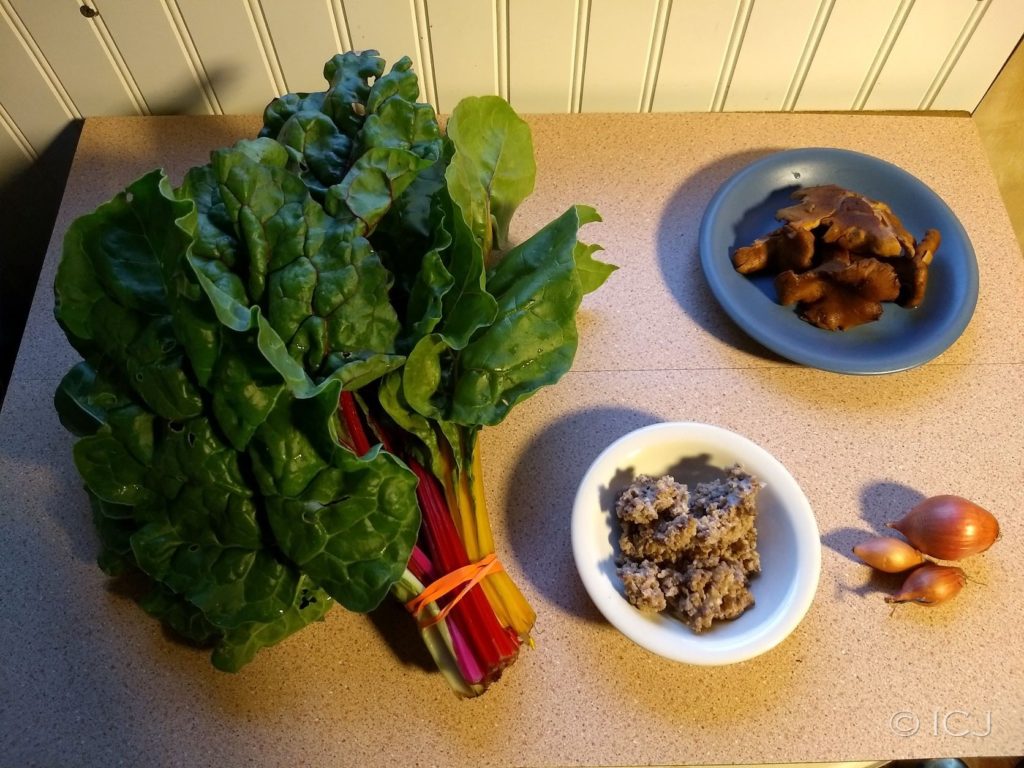
Rainbow chard (Chehalis farmer’s market), shallot (homegrown), browned pork sausage (Mossyrock), chanterelle steamed and frozen last October (foraged Lewis County), olive oil, salt.
The hard cider is from the same round of juicing the apple mash. I added a quarter teaspoon of champagne yeast to a quart jar of it and left it at room temperature for several days with the lid not-quite-sealed and stirred it once a day. It’s gently sparkling and just slightly boozy. PG-13 hooch.
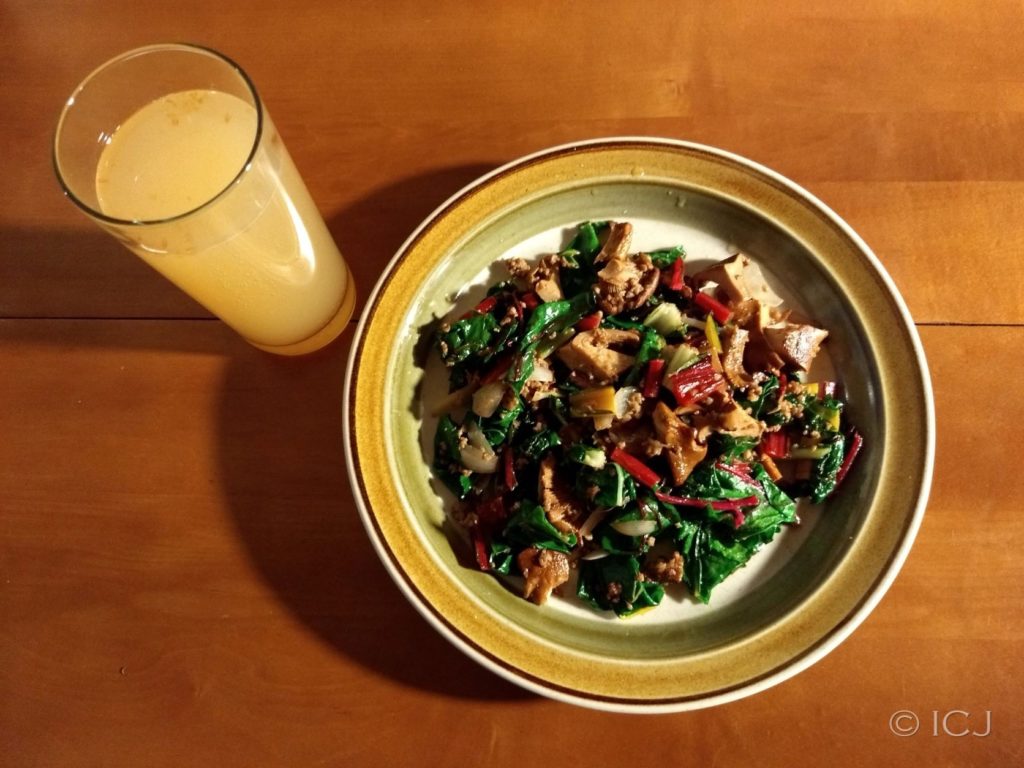
Bedtime: Steamed Milk with Honey
Milk (Glenoma), honey (Four Cedars, Glenoma).
Oh so lovely. One can understand why “the land of milk and honey” was the dream destination. Just the pair are splendid, but make some yogurt, add some nuts and berries . . . or get enzymes and yeast involved and make cheese and mead.

State Foodshed Day – June 26
Breakfast: Pancake with Apricots and Cherries, Coffee
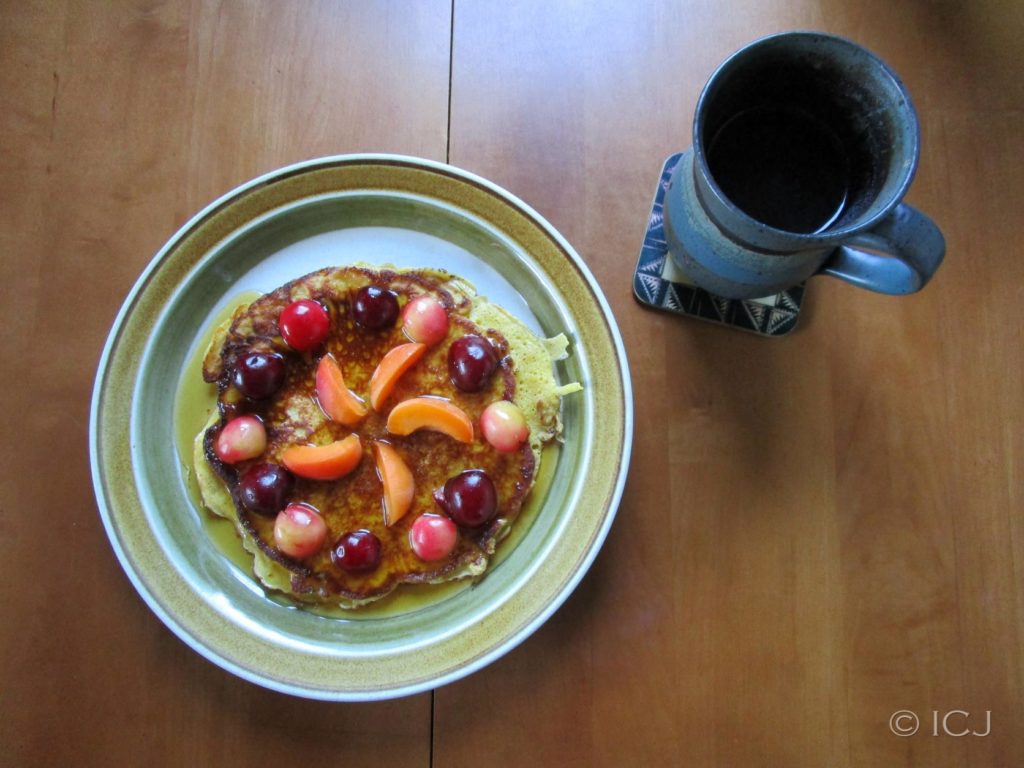
I hope that I can be forgiven for making the pancake my usual way, with just egg, kefir, and 1/3 c Bob’s Red Mill pancake mix. I was flipping it over in the pan before I realized, and did not wish to waste time or food correcting my error. Waking up at dawn on the porch and bracing myself for a 100-degree day is my excuse. I had the WA-grown Bluebird flour on hand. Yakima apricots and cherries found at the Toledo market. Butter for cooking, maple syrup for eating. Nomnomnomnomnom.
Morning Snack: Bluebarb Smoothie
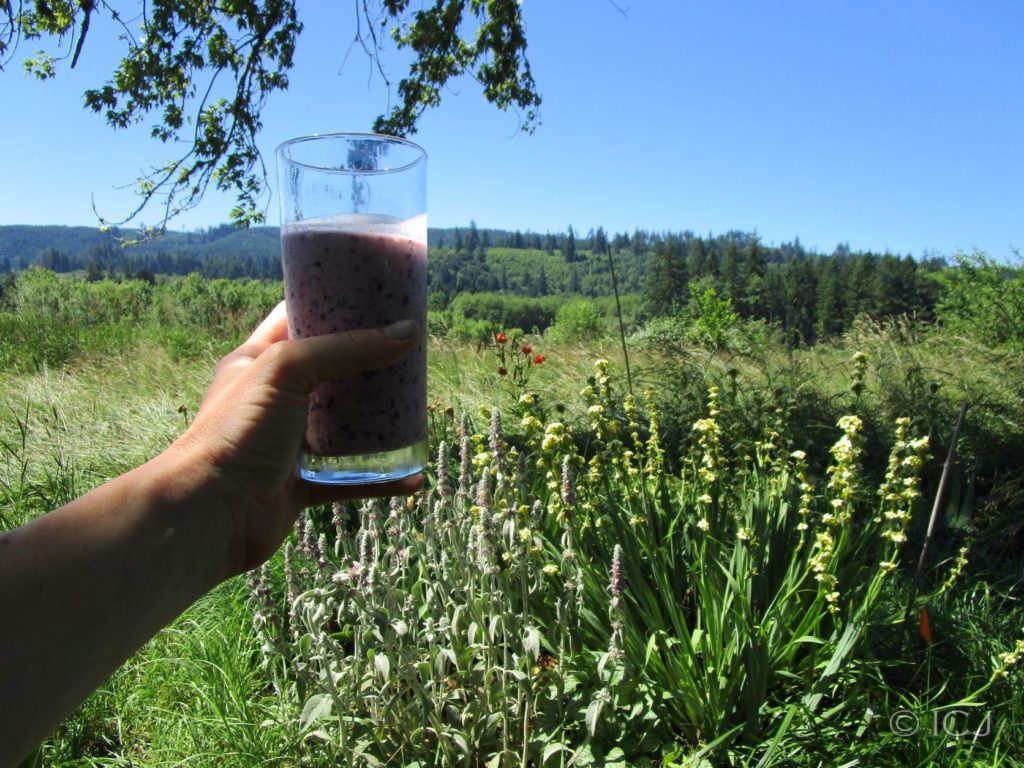
Blueberries (Aldrich Farm, Mossyrock), rhubarb (homegrown), kefir (Grace Harbor, Custer), honey (Beeworks, Bellingham).
Lunch: Raw Kale Salad, Hard-boiled Egg
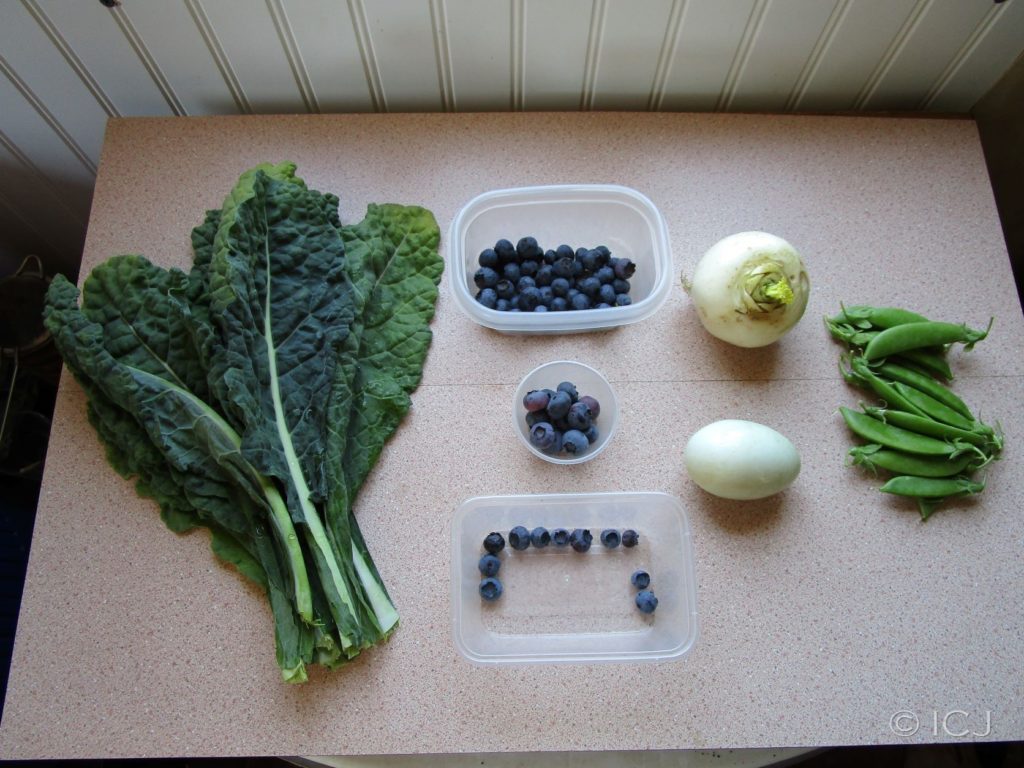
Kale (Root Cellar Farm, Onalaska), sweet turnip (Piece by Piece farm, Olympia), blueberries (homegrown), snap peas (homegrown), olive oil, maple syrup, white balsamic vinegar (Trader Joe’s), salt.
Hardboiled duck egg (Mossyrock).
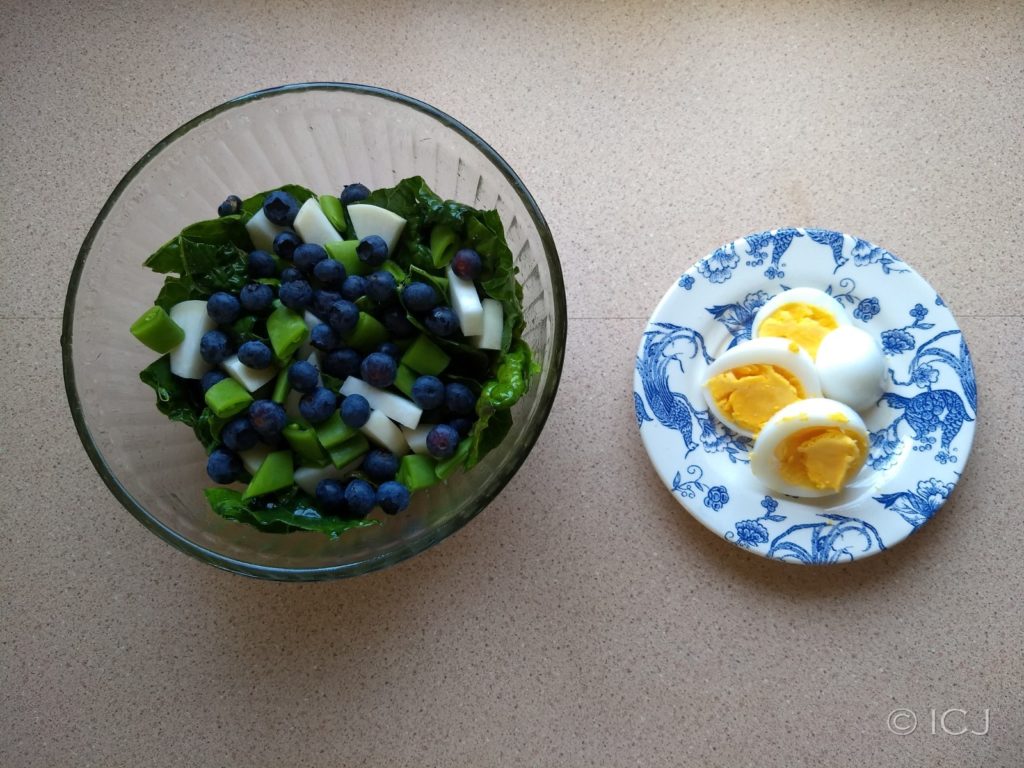
Afternoon Snack: Ice Cream and Strawberries
Same as County Day.
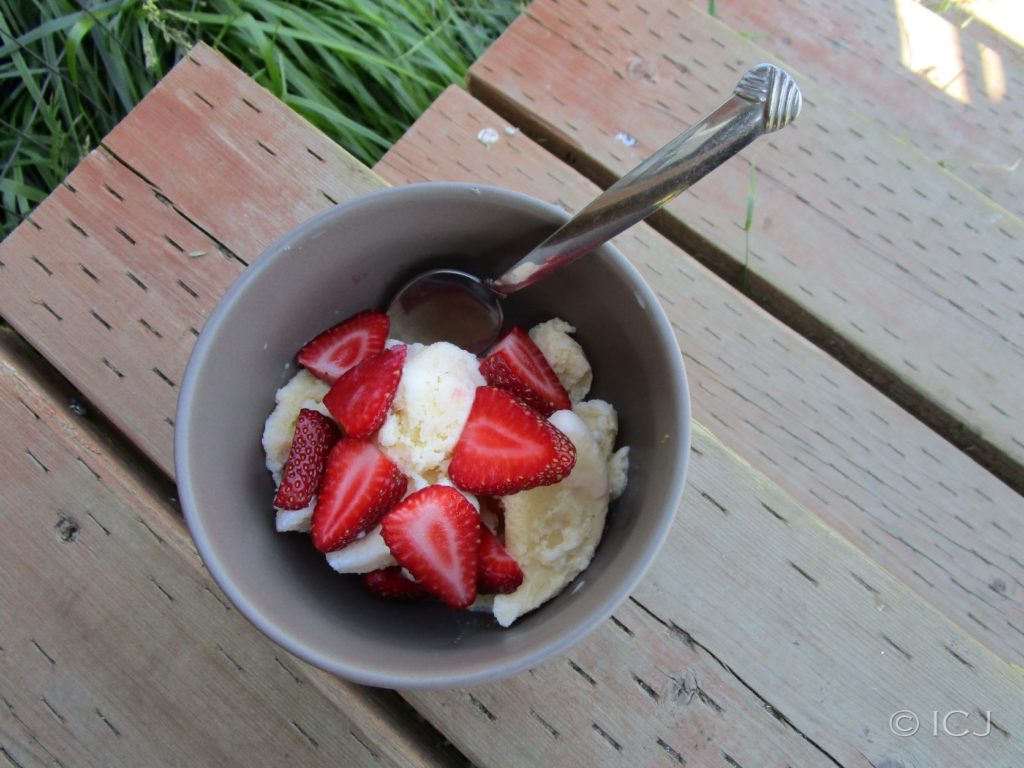
Dinner: Meatballs, Potato Salad, Coleslaw
Cold meatballs thawed from State Food Day batch made in April. So lovely to have a refreshing, filling dinner that requires no cooking when one has spent about 6 hours that day watering and it is just now cooling down to 90 at dark and you are about to spend the second night in a row on your porch.
Coleslaw – Cabbage (Piece by Piece Farm, Onalaska), carrot (Piece by Piece), olive oil, lemon juice, salt, pepper. Potato Salad – Potatoes boiled and cooled (WA via PCC), green onion (Vienna Gardens, Silver Creek), kefir (Grace Harbor), salt, pepper.

